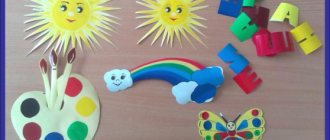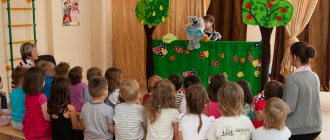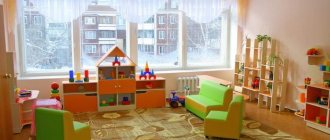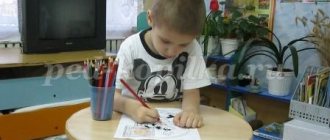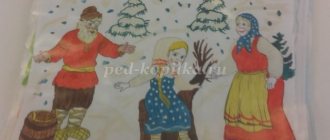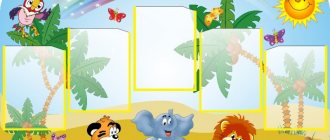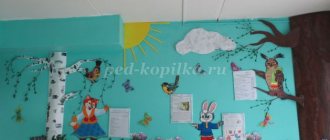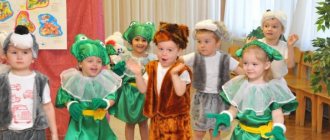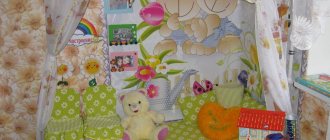Theatrical performance in kindergarten is the goal
Theatricalization is understood as one of the types of play activities used to reveal the deepest creative potential that every child has. When theatricalization, dramatic techniques are used (in other words, role-playing) and various exercises aimed at developing children's acting skills.
A lot depends on the design
For your information. The value of theatricalization lies in the fact that it helps to develop the child’s monologue and dialogic speech and, as a result, improves the level of his communicative abilities.
The theatrical performance includes the following elements:
- improving the expressiveness of characters’ lines;
- development of both active and passive vocabulary;
- work on speech development.
The corner develops thinking
In addition, the use of theatricalization pursues the following goals:
- introduce the child to the world around him;
- promote the development of creative abilities;
- develop the emotional component;
- develop an interest in reading and art;
- develop directing skills;
- learn to embody a character’s character through your own actions.
For your information . Theatrical performance is considered one of the most effective ways to introduce a child to aesthetics, culture and morality.
Theatrical activities in the senior group in kindergarten
Theatrical activities in preschool educational institutions
Goals: • to develop creative independence, aesthetic taste in conveying the image; clarity of pronunciation; • consolidate the ability to use means of expression (posture, gestures, facial expressions, intonation, movements); • cultivate a love for the theater; • develop the independence of preschool children in organizing theatrical activities; • spiritual and moral education of preschool children, the formation of their cultural values, the development of intellectual and personal qualities. Objectives: • develop imagination, artistry, courage when performing in front of an audience; to form the creative beginning of the child’s personality; • creation of a creative atmosphere, an atmosphere of goodwill, • support of educational systems that create conditions for children to participate in creative, purposeful joint activities, their moral and aesthetic education, development of the emotional sphere, and the formation of self-confidence; • strengthening cultural ties between teachers and students’ families, supporting the organization of meaningful leisure time in the family, interest in theater and theatrical activities, events in the cultural life of the city; • organizing conditions for theatrical games, developing children's interest in visiting professional theaters. Monday
“The Magic World of Theater”
03/25/2013 Morning: Conversation “History of the Theater” (video presentation) Purpose:
to tell children about the emergence of the theater and the history of its development.
Morning exercises with elements of psycho-gymnastics. Goal:
increase psychophysical activity and mood.
(children depict animals from fairy tales, the teacher pays attention to facial expressions, pantomime, tension and relaxation of body muscles). Evening: Puppet theater "Teremok". Goal:
to develop verbal and pantomimic expressiveness;
activate speech, develop speech expressiveness; consolidate skills in manipulating bi-ba-bo dolls. Progress of the performance:
Children are asked to choose the hero of the fairy tale whom they want to voice;
remember the sequence of actions. The teacher draws the child's attention to the characteristics of the selected character. The screen is installed. Spectators take their seats. The teacher suggests turning into fairy-tale animals and starting a fairy tale. The teacher leads the main plot line, the children voice the characters. At the end of the performance, the teacher thanks the children for an interesting performance; viewers are interested in which of the characters they liked best and why. The dramatization can be repeated with other children. Tuesday
“Such a different theater”
03/26/2013 Morning: Conversations of young theatergoers about types of theaters. Purpose:
to give an idea of the different types of theaters, their purpose and purpose.
Day: Story-role-playing game “We came to the theater.” Goal:
in a playful environment, to give children an idea of the theater, the rules of behavior during the performance, and intermission.
Progress of the game:
The teacher gathers the children and informs them that today they will go to an improvised theater.
Do children know how to behave in the theater? What happens in the hall, behind the scenes? And so on. The teacher suggests distributing roles between the participants in the game. The game takes place with the direct participation of the teacher who directs the gaming activity. Upon completion, the results are summed up. Evening: Entertainment game-dramatization “Rukavichka” (“Winter quarters”). Goal:
to develop the expressiveness of children’s speech and pantomime;
consolidate knowledge of the content of a fairy tale, the ability to use the attributes of the theater. Progress of the dramatization game:
The teacher offers to name magical objects with which you can get into a fairy tale.
Children call. Then the teacher takes out masks and invites the children to turn into animals from the fairy tale “Rukovichka”. Helps children during dramatization play. At the end, he thanks everyone for the interesting performance. Wednesday
“We are artists, we are spectators!”
03/27/2013 Morning: A surprise moment: introducing children to a “living hand” doll. Goal:
to talk about the variety of puppets in the theater, to give an idea of how to manipulate a given doll.
Psycho-gymnastics “Leopold the Cat and the Mice.” Goal:
to develop pantomimic expressiveness, the emotional, communicative sphere of children, to teach how to regulate muscle tension and relaxation;
determine the nature of movements in accordance with a given image; develop imagination. Day: Drawing competition “The Magical World of Theater”. Goal
: to enable children to convey in their drawings their vision of the theater, the stage, and the characters of the performances;
development of creative and graphic abilities. Evening: Dramatization games, director's games using a doll with a living hand. Goal:
to develop imagination, pantomimic expressiveness.
Progress of the dramatization game:
The teacher suggests remembering what the children learned about the doll “with a living hand.”
Those interested are invited to play, a screen is set up. Children are invited to come up with and act out a plot. Further, the game can go beyond the “theater”, i.e. Children can use the live hand doll for their games. Thursday
“Master of Puppet Affairs”
03/28/2013 Morning: Psycho-gymnastics “Saving kindness.” Goal: to distinguish and name the emotions of pleasure, surprise, admiration and joy, to respond adequately to them; develop attention, learn to relax. Making figurines for the theater on flannelgraph. Goal: to instill a love of manual labor, to arouse interest in creative activities; learn to highlight the characteristics of a character when making figurines. Evening: Theater on flannelgraph based on nursery rhymes and poems. Goal:
consolidate knowledge of nursery rhymes and poems;
develop children's speech, expressiveness, artistry, and develop imagination. Progress of the game:
The teacher draws the children’s attention to the house and the doll on the flannelgraph.
Talks about her. Gives riddles to children. The answers are placed on a flannelgraph. Then the teacher invites the children to perform a nursery rhyme about the chosen hero. At the end, the doll invites everyone to drink tea. The theater smoothly transitions into the game. Friday “Theater, theater!” 03/29/2013 Morning: Exhibition - presentation in the group of different types of theater “Play with us!” Goal: to show the diversity of theaters in the group. Photo collage “Give us applause!” Purpose:
to show the work of teachers and children in theatrical activities organized in a group.
Psycho-gymnastics. Sketches: “Flower”, “The Kitty Woke Up”, etc. Purpose:
to develop imagination, the ability to adequately express emotions of pleasure and joy;
be able to plastically convey transformations. Evening: Theatrical games using human dolls Purpose:
to give an idea of a new type of doll: “human dolls”;
develop imagination, pantomimic expressiveness; be able to organize your theatrical activities taking into account the chosen character. Progress of the game:
Show children costumes for human dolls; talk about their use and purpose. Tell us how it can be used in theatrical games; where can you find similar dolls? Offer to organize a game using the proposed costumes. If the children find it difficult, offer to stage it, act out a fragment from a cartoon with a similar character. Finally, make a comparison between different types of theater; different dolls: which one you like best, which one is more interesting to play with; which Cookom can be used in everyday gaming activities. * * * * * Development of poster information for parents on issues of supporting the organization of meaningful leisure time in the family, interest in theater and theatrical activities.
We recommend watching:
Master Class. DIY shadow theater
Photo report from the fairy tale “The Scarlet Flower” Synopsis of a theatrical lesson in the second junior group Synopsis of a joint theatrical activity in a preparatory group on Russian folk tales
Similar articles:
The fairy tale “At the behest of the pike” in a new way. Role-based script for older preschoolers
Theater corner in kindergarten and its design
The theater corner is a component of the general atmosphere of the group, created with the aim of uniting children and developing new skills and competencies in them.
The classic theatrical corner consists of several components:
- illustrations, photographs, paintings, etc.;
- toys;
- screens (which are used as decorations, as well as curtains);
- additional props (bells, bells, cars);
- decorative elements;
- outfits and masks;
- demonstration stands;
- library sector.
Illustrations and toys are important in the corner
The theater corner should be equipped in such a way as to make theatrical activities effective.
For your information. When designing a theater corner, it is fundamentally important to take into account the age group of children, take into account the group and personal characteristics of children, their interests and aspirations.
Junior group
In nurseries and the first group of kindergarten, it is better to pay attention to finger theater. It requires dolls that fit on each child’s finger and develop fine motor skills well.
Almost any material can be used to make such dolls. It could be fabric, felt, paper, polymer clay.
The next stage, which occurs at the junior group level, is teaching children how to properly play with toys on the table surface, as well as developing finger theater skills. The task of this stage is to train the coordination of the child’s movements and further develop his fine motor skills.
For your information . In order to make such a prop yourself, you will need cones made of hard paper or cardboard. In addition, the use of bibabo (a set of glove puppets) seems advisable at this age.
Children in this age group should do:
- finger theater;
- tabletop theater;
- theater of soft and knitted toys;
- theater of toy-cones.
Middle group
Children need to hone all previously acquired skills, so classes started in previous years should not be interrupted. At the same time, it is necessary to introduce new types of theatricalization. At this stage of child development, the theater of spoons is appropriate. To “cook” the characters in the productions, ordinary plastic utensils are used here. At the same time, the theater screen began to be used.
Development of logical thinking in preschoolers
For your information . You can introduce children to dolls on the gapite. Hapit is a wooden rod. These props will help kids learn the basics of puppeteering.
During centralization classes, children in the middle group are given a more complex task. They need to bring their own movements and the plot of the production into agreement. The theater begins to represent an action that has a clear storyline and meaning. This requires the baby to reach a new level of development of coordination and motor skills.
Options for middle group children:
- finger theater;
- tabletop theater;
- dolls on gapits;
- glove puppets.
Senior kindergarten group
During training in the senior group, it is recommended to start using puppets during theatrical classes. These dolls are characterized by an unusual way of bringing them into a state of movement. A special thread holder (cross) is responsible for this process. It is to it from below that the “body” of the toy is directly attached.
In addition, special attention should be paid to the process of voicing the characters, because the goal of theatrical classes at this stage is to teach children to use vocal intonations to convey emotions.
The optimal options are:
- finger theater;
- glove puppets;
- puppets.
In the preparatory group
At this stage, the child already becomes a “real” actor. He must transform into his hero by reproducing his manner of moving, speaking, and behaving. The child must learn to imitate the voice and correctly express the emotions and experiences of the hero. For a more accurate and real transformation, children dress up in stage costumes.
Life-size puppets develop well
At this age, it is possible to use a wide range of props, for example:
- finger puppets;
- changelings;
- glove puppets;
- puppets;
- life-size puppets;
- cane dolls.
At the same time, it is worth taking into account a certain convention of the above distribution of activities in the theater club depending on the age group of the child.
For your information. It is necessary to take into account the general level of the group, the specifics of the child, and the presence of interest in a certain type of theatrical activity.
It is a completely normal practice for children of middle and senior age to participate in costume performances. Glove puppets can be successfully used in theatrical performances even for children 5–6 years old.
How to properly decorate a theatrical corner in DOUstatya groups
How to creatively and competently design a theater corner in kindergarten
Preschoolers spend most of the day in kindergarten. Each element of the design of a group space is of great importance, since it influences the formation of aesthetic taste in children. And, of course, any detail of the situation should carry a semantic load. In order for the theater corner to meet these requirements, its structure and content should be carefully considered.
The meaning and purposes of theatricalization
Theatricalization is a type of play activity that is used to reveal the creative potential of children using dramatization techniques, that is, role-playing according to a pre-agreed scenario, as well as various exercises aimed at mastering acting skills.
Theatricalization is valuable because it includes work on the development of monologue and dialogic speech, and this increases the communication skills of children. Theatricalization involves:
- working on the expressiveness of characters’ lines;
- expansion of the child’s active and passive vocabulary;
- improving the pronunciation of speech sounds, as well as intonation structure.
In addition, the goals of theatricalization are:
- comprehensive acquaintance with various manifestations of reality (professions, animals, natural phenomena);
- stimulation of the child’s creative potential (through songs and music, dancing, games);
- development of the child’s emotional sphere due to deep experiences during the game;
- formation of social behavior skills;
- introducing preschoolers to reading;
- development of directing skills;
- embodiment in a creative impulse of the mood, character and process of character development of the character.
Theater is a magical world. He gives lessons in beauty, morality and ethics. And the richer they are, the more successful the development of the spiritual world of children is...
B. M. Teplov, Soviet psychologist
Video: presentation of types of theater for kindergarten (tabletop from knitted toys, on jars, on spoons, shadow theater)
How to organize a theater corner in kindergarten
The theatrical corner is part of the developmental environment in the group’s equipment, designed to unite the children with a common play activity in which they could demonstrate all the facets of their character, perhaps not yet known to them. The standard (that is, for general education groups) theater corner includes:
- pictures, including three-dimensional ones for the cone theater;
- toys for shadow theater, finger theater, bibabo, dolls on clothespins, felt characters for flannelgraph;
- screen (in kindergartens a universal screen is usually used, which acts as both a background decoration and a curtain);
- props (soft toys, cars, etc.);
- materials for making elements of images, decorations (pieces of fabric, cardboard, paper, etc.);
- masks;
- costumes;
- books;
- music library;
- stand with posters and work results (drawings, crafts, etc.).
The purpose of the theater corner is to provide conditions for full-fledged work related to theatricalization. But each age group has its own specific range of tasks for which one or another type of theater can be used.
- First junior group. Children get acquainted with the finger theater, in which dolls are created (sewn from fabric or felt, made from paper, molded from polymer clay, etc.) for each finger and, if desired, decorated with buttons, threads, braid and lace. The task is to learn to control the movements of your own fingers.
You can make puppets for finger theater yourself or buy them in a store.
- Second youngest. Kids learn to work with dolls on the table or glove toys. The characters of the tabletop theater are made from paper cones, cylinders, or are fabric glove dolls - bibabo. The goal is to train coordination and fine motor skills.
Bibabos are very popular with children, as they are quite easy to control.
- Middle group. In addition to practicing the skills they have already acquired, the children learn to work with the spoon theater, in which characters are made on the basis of plastic utensils, get acquainted with a theatrical screen (working as a curtain and/or backdrop), a puppet on a wooden rod - gapite, and also master the basics of puppeteering . The task is to coordinate movements with the plot of the story, work on developing coordination and fine motor skills.
For spoon theater, you can use both plastic and wooden spoons.
- Senior group. The guys get acquainted with puppets. They are set in motion using a cross - a holder of threads on which the toy is suspended. The task is to master the subtleties of voice intonation that convey different emotions.
Puppet theater - fun with a centuries-old history
- Preparatory group. Working as an actor in a costume theater, where a child needs to completely transform into his character, repeating his movements, demeanor, voice, etc. In some preschool educational institutions that have similar props, children also have the opportunity to work with floor and scarf dolls.
Costume performances are a classic of theatrical activity
However, this division is still very conditional: elements of a costume production can be included in the holiday scenario for the middle group, and glove puppets can be used for the organizational part of any lesson with older preschoolers. The teacher must focus on the real situation and his own experience.
Bibabo is a doll consisting of a head and a glove suit. There is a hole in the head for the index finger, and the hands are controlled by the middle and thumb.
Contents of corners for different ages by type of theatrical performance
The content of the theater corner should be understandable to children, that is, they should be able to interact with dolls and manipulate them.
For younger children:
- finger theater (sketches on hands);
- tabletop theater (various types);
- soft toy theater (studies with objects);
- theater of knitted toys (studies with objects);
- theater toys from a cone (studies with objects).
For middle age:
- finger theater (sketches on hands);
- tabletop theater (various types);
- doll on a gapit, on an elastic band (working with objects on a rod or on threads);
- dolls gloves (plastic studies on hands).
For the older group:
- finger theater (sketches on hands);
- doll gloves (plastic studies on hands);
- puppets (staging sketches and improvisations).
For the preparatory group:
- finger theater (sketches on hands);
- shapeshifting dolls (games of transformation);
- dolls gloves-mittens (plastic studies on hands);
- puppets (staging sketches);
- life-size puppets (musical and plastic sketches);
- cane puppets (staging sketches, fairy tales).
Where to place the theater corner
In modern kindergartens, where space is quite limited, it can be quite difficult to allocate separate places for corners (theater, outside world, etc.). Therefore, the educator can combine educational centers into a complex. For example, for the areas of theater, visual arts and music, you can organize a single artistic and creative corner. At the same time, we must not forget that the subject content must comply with a number of principles:
- mobility (materials for music classes can be illustrative and for theatrical performance);
- turnover (the contents of the corner should change depending on the goals of educational work in a given month, the direction of the group’s specialization, the time of year, the interests of the children, the degree of wear and tear of materials);
- accessibility (all children have the same rights and responsibilities related to the use of the attributes of the theater corner);
- aesthetics (the center itself and all its components should look beautiful, be clean and tidy).
It will be very convenient if you place a table or cabinet with shelves in the theater corner on which you can place materials and dolls.
Photo gallery: examples of different theater corners
A mirror in the dressing area is an irreplaceable thing
Zoning is an important element of creating a corner
On the table and shelves the theater corner becomes compact
How to decorate a theater corner
It is necessary to think through not only the content side of the content (what dolls, masks and devices will be in the corner), but also what and how all these elements can be made from. You can buy a lot of things ready-made, but some things are easier and healthier to make yourself. It is worth involving children in the making of some items.
Table: ideas for making props
| What | What can it be made from? |
| Types of theaters and puppets | |
| Tabletop theater | Doll toys can be made from cardboard or paper. For a tabletop theater, they can be glued together in two parts and mounted on stands made of plastic, wood or thick cardboard. Another way is to stick the image on a cone or cylinder. |
| Finger Theater | Dolls can be created using paper or fabric, decorated with threads, buttons, braid, etc. You can also knit some characters. |
| Glove puppets | One glove is stitched at the level of the fingers from the inside out, turned inside out, stuffed with cotton wool or padding polyester and decorated, and sewn to the second one. |
| Dancing toys, cardboard puppets | Individual parts are cut out of cardboard: torso, arms, legs. After which the elements are connected with threads or wire. |
| Bibabo | Bibabo dolls can be made from nylon stockings. |
| Theater on flannelgraph | Characters for the theater on felt flannelgraph. |
| Theater on spoons (plastic or wooden) | Cardboard parts are glued onto the base, which are then draped with fabric and decorated. You can also use acrylic paints, plasticine and other materials. |
| Floor dolls | Soft dolls the size of a child are sewn in the same way as ordinary soft toys. If necessary, you can insert elements of a frame base into the doll (so that the body does not bend), and also sew loops to make it easier for the child to control the doll. |
| Scarf dolls | A wide ribbon is sewn to the cardboard head, and from below it is sewn onto a scarf or dress with sleeves. The child puts on such a costume and controls the character using an elastic band that is attached to the sleeve. |
| Shadow play | The character's head is cut out of cardboard, and a paper tube is attached to it for the actor's index finger. We mark the eyes with a puncture. For performances, you need an old TV and a lamp to direct the light source. |
| General and additional details | |
| Scenery | Trees, the sun, a clearing, etc. are made of thick paper and glued to a cardboard base. |
| A curtain | The curtain is made of corrugated paper or ordinary fabric. |
| Screen | It can be made of wood or thick cardboard. |
| Programs | Panorama books can be used, for example, as programs for staging. |
| Tickets | Tickets are made from paper or cardboard and then laminated or covered with tape. |
The theater corner must be divided into zones
How to make a screen for a puppet theater
This essential element can be made in different ways.
Materials:
- plywood sheet;
- jigsaw;
- a piece of fabric or a piece of thick wallpaper;
- PVA glue;
- small door hinges.
Instructions:
- From plywood we cut out blanks for two sidewalls and one central part of the screen.
Plywood screen will last a long time
- We carefully cover them with wallpaper or cloth.
- Let it dry.
- We attach the hinges to the areas indicated in the drawing - this is how the screen will fold and unfold.
How to make a screen for a finger theater
Making such a screen will not be difficult.
The screen for the finger theater can be painted and decorated - this way you will immediately get the scenery for the production
Instructions:
- Take a cardboard box of a suitable size. As a rule, the size is selected taking into account the size of the table on which the theater will be located.
- Let's analyze it.
- Cover with colored paper.
- We bend the sides, leaving a sufficiently sized canvas in the center.
- We make a cutout in the center.
- We color and decorate.
How to make a curtain
To sew a fabric screen, you need to know how much space is allocated for it. The fabric is usually taken in a ratio of 1:3 so that the finished curtain drapes beautifully.
Materials:
- wooden or iron strips into which the screen will be threaded;
- fabric (organza or any other non-transparent but well-draped material);
- thread, needle, sewing machine;
- nails or screws for attaching the plank.
Instructions:
- We attach two short ones to the long bar.
- We nail one short one to the wall.
- We process the edges of the fabric.
- Along one long edge we make a bend slightly larger than the width of the plank.
- Let's stitch it.
- We thread the frame into the fabric screen.
Handkerchief dolls can be given handles and other decorative details can be added.
In addition, to decorate a theater corner you can use:
- children's drawings (for example, sketches of impressions of what they saw on stage);
- crafts (favorite fairy tale hero made of plasticine);
- colorful inscriptions that divide the corner into zones (dressing room, costume room, etc.).
Photo gallery: drawings of screens for a theater corner
The folding screen has a wooden base (you can use slats)
The screen can be decorated with various decorative elements
The dimensions of the screen can be adjusted to fit a specific theater area - just follow the principles of symmetry
Photo gallery: various elements of the theater corner
For a theater corner it is convenient and practical to use a table with shelves
Decorations can be created based on illustrations in the book
You can use egg caps from Kinder Surprise as a base for toys on a cone.
How to create a passport for a theater corner according to the Federal State Educational Standard
The content of the theater corner is determined by the requirements of federal state educational standards - Federal State Educational Standards. In accordance with the requirements of the document, the corner as a means of theatricalization should contribute to:
- memory training, thinking processes;
- development of socio-cultural and cognitive skills;
- speech and physical development;
- nurturing a culture of knowing yourself and the people around you.
Working in the theater corner, among other things, fosters a sense of camaraderie in children
The passport includes 8 positions with a detailed description of each:
- Name of the preschool educational institution.
- Name of the group and corner.
- Authors and designers.
- Zones included in the project. When zoning a corner, it is important to take into account that a screen and a costume room with props are mandatory elements, the rest are organized at the discretion of the kindergarten methodological council:
- costume department;
- dressing room;
- workshop for creating scenery, dolls and other attributes;
- spectator area;
- books, audio and video materials;
- screen;
- doll storage cabinet;
- area representing the effectiveness of the group’s work in the field of theatricalization.
- Filling each zone.
- Children's age.
- A list of types of work taking into account the age of the children (suitable ones for the group are selected). So, in the first junior group, theatrical performances with hand puppets will be too difficult for kids, but a performance with finger theater puppets will be quite feasible.
- Guidelines. Instructions regarding the regularity with which classes should be conducted (for example, 2 times a week in the form of circle work), as well as the duration of classes (in the older group - 20–25 minutes). In addition, a list of tasks that are included in the general educational goals for a specific age group, a list of exercises for developing theater skills, a form of work performance (drawings, projects, photographs).
A partition for changing clothes is a rather cumbersome prop, so in practice they often do without it.
Table: possible filling of the theater corner zones (item No. 5 of the corner passport)
| Zone name | Filling |
| Costume room | National costumes, costumes of domestic and wild animals, birds, hats, caps, gloves, baskets, etc. |
| Dressing room | Face painting, wigs, pince-nez, etc. |
| Spectator area | Chairs, cash register, bell. |
| Area for making decorations | Paints, tapes, waste material, paper, etc. |
| Cabinet for storing different types of dolls | Life-size puppets, tabletop theater characters, flannelgraph, finger theater, bibabo, spoon theater with the names of the characters. |
| Book area | Books on current topics, including homemade books, panoramic books, magazines, board games. |
| Music zone | Audio library, video materials, chants (short works with a simple melody), ditties, songs, etc. |
| Screen | For a finger theater, for a shadow theater (an old TV and 2 lamps), a partition corresponding to the height of the baby. |
| Area for placing posters and the results of theatricalization work | Stands, photos, drawings, crafts and more. |
The content of the zones described above is the result of an analysis of the practical experience of educators. In each individual case, the teacher fills the theater corner in accordance with the specific objectives of the educational process and the capabilities of the kindergarten.
Table: types of activities possible in the theater corner (point No. 7 of the corner’s passport)
| Kind of activity | Content |
| Gaming | Theatrical games, simulation games, role-playing dialogues, dramatizations, director's games, games with building materials, didactic games (with objects, moving ones, writing scripts, etc.). |
| Reading and discussion of literary works | Free communication, solving problems described in the plot, designing exhibitions of drawings, crafts on topics, etc. |
| Looking at illustrations | View and discuss illustrations for various works of art, etc. |
| Communication | Discussion, scripting, games, including quizzes after watching performances, etc. |
| Cognitive elements | Gaining knowledge about the theater, professions related to it, familiarity with the genres of theatrical performances, etc. |
| Productive work | Creation of scenery, costumes, illustrations for works, etc. |
| Musical arrangement | Noise orchestra, dance sketches, performance of songs, ditties, etc. |
| Viewing and discussion of performances | Include a list of performances. |
| Acting out fairy tales | List the fairy tales. |
| Articulation and finger gymnastics | Give the names of the exercises and write down their goals. |
Examples of theater corner names
Correct design of the corner includes an appropriately chosen name. It does not have to be similar to the name of the group; it is enough to reflect the relevant activity:
- "The group... represents";
- "Fairytale Island";
- "Theaters";
- "Grandmother's Tales";
- “And again the fairy tale calls us”;
- "Fairy tale".
In addition to the name, you can come up with a logo for the theater corner
Work in the theater corner
Activities related to theatrical performances in kindergarten are implemented by several types of play activities:
- Director's games. In them, the child only leads the doll, conveying the image of the character with intonation and some other techniques. The possibilities of pantomime here are also very limited, because the toy is almost static (puppets on canes, puppets).
- Dramatizations. The baby plays the role himself, without resorting to the mediation of dolls. The young actor is able to actively use intonation, facial expressions, movements and gestures to enter into the character of the hero.
- Dramatizations with bibabo, finger, floor or scarf puppets. The baby acts for the character, giving him his voice. The work is carried out from behind a screen or with a character in hand.
4.Improvisation. Children act out themes, not plots. Such theatrical activity requires almost no preparatory work, but is the most complex type of game. Various theatrical props can be used for improvisation.
The theater corner, which has everything necessary for the relevant activity, allows you to create a comfortable environment in the group for the development of the creative abilities of students. Theatricalization is a special area of the educational program for preschool institutions, because it gives children the opportunity not only to explore the world around them, but also to learn to live in harmony with it. In addition, theatrical performances help children become more self-confident, which is also important for their personal growth - which means that a kindergarten cannot be without a theater corner.
How to make a theater corner passport
The theatrical corner, or rather, its design, must be carried out in accordance with federal state educational standards (abbreviated as Federal State Educational Standards). Designing a theater corner in a kindergarten according to the Federal State Educational Standard requires compliance with certain standards.
The Federal State Educational Standard prescribes that the theatrical corner should provide:
- development of abilities to remember information;
- development of the child’s thought processes;
- development of sociocultural concepts in children;
- strengthening speech capabilities;
- physiological development;
- introduction to a culture of behavior in society;
- knowing yourself as a person.
The passport according to the Federal State Educational Standard includes eight positions. At the same time, the standard provides a detailed description of each of them:
- The inscription of the full name of the child care institution.
- Designation of the group and name of the theatrical corner.
- The authors who designed the corner.
- Name and description of zones that are part of the project. Mandatory elements are a screen and a wardrobe. Zoning of other parts occurs at the discretion of competent persons. In total, we can highlight a costume room, a dressing room, a workshop, an auditorium, a library (including the availability of video and audio materials), a screen, cabinets for storing props, and an area dedicated to the results and achievements of children in the field of theatrical performance (stand).
- Occupancy of each of the existing zones.
- Age indicators of pupils.
- A list of activities that are implemented at a specific age stage during theatrical classes.
- Various methodological developments, recommendations, templates and presentations. They mean advice regarding the frequency of appropriate activities and their duration. It also includes tasks assigned to a specific group, a list of exercises that are required to be performed during theatrical classes for representatives of a specific group.
Didactic games using the Montessori method for children
